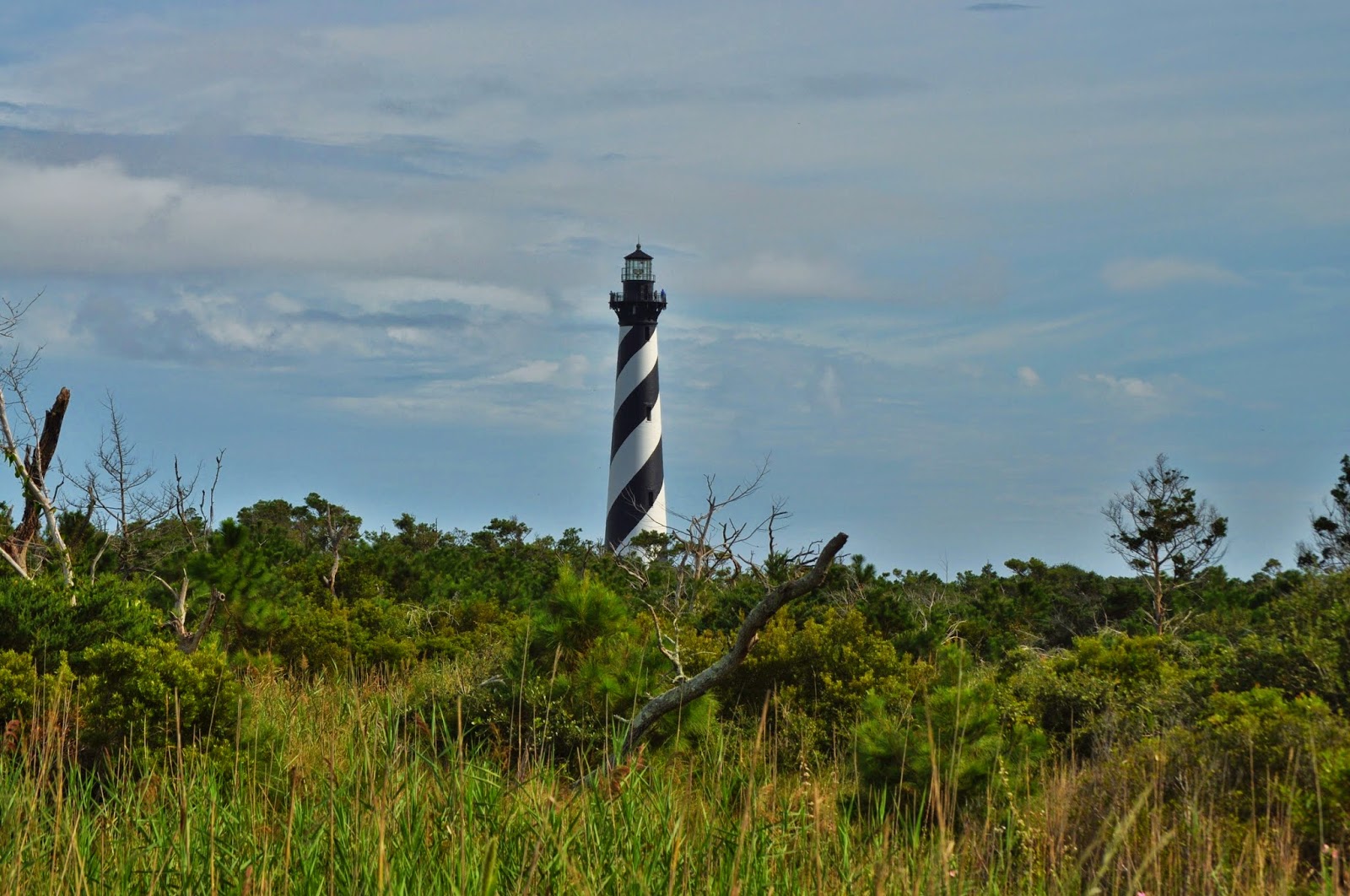
Sunday, September 7, 2014
CAPE HATTERAS LIGHTHOUSE-HATTERAS ISLAND, NORTH CAROLINA
At the behest of mariners and officers of the U.S. Navy, Congress appropriated $80,000 to the United States Lighthouse Board to construct a new beacon at Cape Hatteras in 1868. The Light-House Board was a federal agency under the direction of the Treasury Department but was headed by a multi-agency committee. The Board consisted of two Army Engineers, two Navy officers, two civilian scientists, and one additional officer from both the Army and Navy to serve as secretaries. Congress established the Board in 1852 for the purpose of creating a unified, continuous system of navigational aides along the coasts. Prior to 1852, lighthouse construction generally rested with local authorities, ultimately leading to a disjointed, ineffective national system. Under the Light-House Board, Navy officers determined where new lighthouses were needed; Army Engineers selected exact locations, designed, and built them; and civilian scientists developed new technologies and techniques for displaying bright, consistent beacons. Completed in just under two years under the direction of Brever Brigadier General J. H. Simpson of the U.S. Army Corps of Engineers, the new Cape Hatteras lighthouse cost $167,000. The new tower, from which the first-order light was first exhibited December 16, 1871, was the tallest brick lighthouse tower in the world. It was 200 feet (61 m) above ground and the focal height of the light was 192 feet (59 m) above water. The old tower "being no longer of any use and in danger of falling during some heavy storm" was demolished in February 1872. In the spring of 1879 the tower was struck by lightning. Cracks subsequently appeared in the masonry walls, which was remedied by placing a metal rod to connect the iron work of the tower with an iron disk sunk in the ground. In 1912 the candlepower of the light was increased from 27,000 to 80,000. The Civilian Conservation Corps and Works Progress Administration erected a series of wooden revetments which checked the wash that was carrying away the beach. In 1942 the Coast Guard resumed its control over the tower, and manned it as a lookout station until 1945. The old tower was now 500 to 900 feet (270 m) inland from the sea and again tenable as a site for the light, which was placed in commission January 23, 1950. The new light consisted of a 36-inch (0.91 m) aviation-type rotating beacon of 250,000 candlepower, visible 20 miles (32 km), and flashing white every 7.5 seconds. The skeleton steel tower was retained to guard against the time that the brick tower may again be endangered by erosion and thus require that the light again be moved. The light displays a highly visible black and white diagonal Daymark paint job. It shares similar markings with the St. Augustine Light. Another lighthouse, with helical markings—red and white 'candy cane stripe'-- is the White Shoal Light (Michigan), which is the only true 'barber pole' lighthouse in the United States. Its distinctive "barber pole" paint job is consistent with other North Carolina black-and-white lighthouses, "each with their own pattern to help sailors identify lighthouses during daylight hours." The National Park Service acquired ownership of the lighthouse when it was abandoned in 1935. In 1950, when the structure was again found safe for use, new lighting equipment was installed. Now the Coast Guard owns and operates the navigational equipment, while the National Park Service maintains the tower as a historic structure. The Hatteras Island Visitor Center, formerly the Double Keepers Quarters located next to the lighthouse, elaborates on the Cape Hatteras story and the lifestyle on the Outer Banks. Cape Hatteras Lighthouse, tallest in the United States, stands 208 feet (63 m) from the bottom of the foundation to the peak of the roof. To reach the light, which shines 191 feet (58 m) above mean high-water mark, requires climbing 268 steps. In 1999, the Cape Hatteras lighthouse had to be moved from its original location at the edge of the ocean to safer ground 1,500 feet (460 m) inland. Due to erosion of the shore, the lighthouse was just 15 feet (4.6 m) from the ocean’s edge and was in imminent danger. International Chimney Corp. of Buffalo, New York was awarded the contract to move the lighthouse, assisted, among other contractors, by Expert House Movers. The move was controversial at the time with speculation that the structure would not survive the move, resulting in lawsuits that were later dismissed. Despite some opposition, work progressed and the move was completed on September 14, 1999. The Cape Hatteras Light House Station Relocation Project became known as “The Move of the Millennium.” General contractor International Chimney and Expert House Movers won the 40th Annual Outstanding Civil Engineering Achievement Award from the American Society of Civil Engineers in 1999. The prestigious Outstanding Projects and Leaders (OPAL) Award recognizes and honors outstanding civil engineering leaders whose lifetime accomplishments and achievements have made significant difference. The Cape Hatteras Lighthouse is the tallest masonry structure ever moved (200 feet tall and weighing 5,000 tons).
Subscribe to:
Post Comments (Atom)






No comments:
Post a Comment